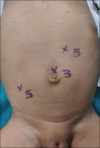Laparoscopic pyloromyotomy for congenital hypertrophic pyloric stenosis: Our experience with twenty cases
- PMID: 33595535
- PMCID: PMC8109752
- DOI: 10.4103/ajps.AJPS_119_20
Laparoscopic pyloromyotomy for congenital hypertrophic pyloric stenosis: Our experience with twenty cases
Abstract
Purpose: Laparoscopic pyloromyotomy for hypertrophic pyloric stenosis has become quite popular over the past decade. There have been many modifications in the technique initially described by Alain et al. in 1991. We describe our experience of the laparoscopic procedure performed in twenty cases.
Materials and methods: This study includes twenty patients of pyloric stenosis who underwent laparoscopic pyloromyotomy from March 2017 to March 2020. All the infants had classical clinical symptoms and abdominal ultrasound confirming the diagnosis of pyloric stenosis. Two 3-mm ports and one 5-mm port were used. The duodenum was grasped to stabilise the olive; a stab knife cut to 10 mm and mounted on a needle holder was introduced through the 3-mm trocar in the left hypochondrium to perform the myotomy, and subsequently, the myotomy was spread with a 5-mm Maryland forceps. Feeding was started 6 h postoperatively.
Results: Twenty patients with congenital idiopathic pyloric stenosis underwent laparoscopic pyloromyotomy by this technique. The average operating time was 42 min. There were no peri- or post-operative complications. The post-operative hospital stay ranged between 36 h and 54 h.
Conclusion: Laparoscopic pyloromyotomy using a stab knife mounted on a needle holder is a technically feasible, safe and effective surgical procedure for pyloric stenosis.
Keywords: Congenital hypertrophic pyloric stenosis; laparoscopy; pyloromyotomy; stab knife.
Conflict of interest statement
None
Figures
Similar articles
-
Single-Site Umbilical Laparoscopic Pyloromyotomy Using a Pyloric Electrocoagulation Chisel Combined with a Left-Handed Main Operation for Congenital Hypertrophic Pyloric Stenosis.J Laparoendosc Adv Surg Tech A. 2020 Nov;30(11):1248-1252. doi: 10.1089/lap.2020.0478. Epub 2020 Aug 20. J Laparoendosc Adv Surg Tech A. 2020. PMID: 32833592
-
Laparoscopic pyloromyotomy for hypertrophic pyloric stenosis: a survey of 407 children.Pediatr Surg Int. 2018 Apr;34(4):421-426. doi: 10.1007/s00383-018-4235-3. Epub 2018 Feb 6. Pediatr Surg Int. 2018. PMID: 29411105
-
Preliminary experience with a new approach for infantile hypertrophic pyloric stenosis: the single-port, laparoscopic-assisted pyloromyotomy.Surg Endosc. 2011 Jun;25(6):2039-43. doi: 10.1007/s00464-010-1505-0. Epub 2010 Dec 7. Surg Endosc. 2011. PMID: 21136088
-
Single-incision versus conventional laparoscopic pyloromyotomy for pediatric hypertrophic pyloric stenosis: a systematic review and meta-analysis.Int J Colorectal Dis. 2023 May 8;38(1):118. doi: 10.1007/s00384-023-04402-z. Int J Colorectal Dis. 2023. PMID: 37154949
-
Open Versus Laparoscopic Pyloromyotomy for Pyloric Stenosis-A Systematic Review and Meta-Analysis.J Surg Res. 2022 Jun;274:1-8. doi: 10.1016/j.jss.2021.12.042. Epub 2022 Feb 2. J Surg Res. 2022. PMID: 35104694
Cited by
-
The Safety and Effectiveness of Laparoscopic Pyloromyotomy Using 3-mm Electrocautery Hook versus Open Surgery for Treatment of Hypertrophic Pyloric Stenosis in Infants.Children (Basel). 2021 Aug 13;8(8):701. doi: 10.3390/children8080701. Children (Basel). 2021. PMID: 34438592 Free PMC article.
References
-
- Ramstedt C. For the operation of congenital pyloric stenosis. Med Klinik. 1912;8:1702–5.
-
- Alain JL, Grousseau D, Terrier G. Extramucosal pyloromyotomy by laparoscopy. Surg Endosc. 1991;5:174–5. - PubMed
-
- Bufo AJ, Merry C, Shah R, Cyr N, Schropp KP, Lobe TE. Laparoscopic pyloromyotomy: A safer technique. Pediatr Surg Int. 1998;13:240–2. - PubMed
-
- Hall NJ, Pacilli M, Eaton S, Reblock K, Gaines BA, Pastor A, et al. Recovery after open versus laparoscopic pyloromyotomy for pyloric stenosis: A double-blind multicentre randomized controlled trial. Lancet. 2009;373:390–8. - PubMed
-
- Ostlie DJ, Woodall CE, Wade KR, Snyder CL, Gittes GK, Sharp RJ, et al. An effective pyloromyotomy length in infants undergoing laparoscopic pyloromyotomy. Surgery. 2004;136:827–32. - PubMed
MeSH terms
LinkOut - more resources
Full Text Sources
Other Literature Sources
Miscellaneous




